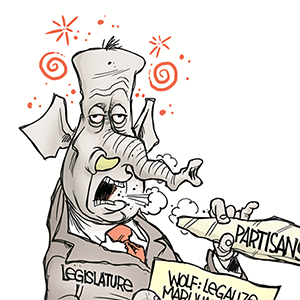Trump's health agency streamlining goals hit roadblock
Published in Health & Fitness
WASHINGTON — Five months after the Trump administration rolled out its grand plans for a signature “Make America Healthy Again” agency, Congress has shied away from taking steps to bring the new agency to fruition.
Health and Human Services Secretary Robert F. Kennedy Jr. announced his plan for the agency in March amid a wide-scale restructuring of the department intended to streamline duplicative efforts and cut costs.
But the department’s plans to consolidate the Office of the Assistant Secretary for Health, the Health Resources and Services Administration, the Substance Abuse and Mental Health Services Administration, the Agency for Toxic Substances and Disease Registry, the National Institute for Occupational Safety and Health and portions of the Centers for Disease Control and Prevention into the new Administration for a Healthy America, or AHA, have been stalled by ongoing litigation and a lack of congressional buy-in.
A second White House proposal would also include the National Institute of Environmental Health Sciences.
The White House’s fiscal 2026 budget request calls for $14.1 billion in discretionary funding to establish the AHA, with the lion’s share coming from the Labor-HHS-Education spending bill and $52 million from Interior Department funding.
The Senate’s bipartisan Labor-HHS-Education spending bill would not appropriate any money for the new agency. Neither would the House or Senate’s marked up Interior funding bills. It’s unclear if the House’s Labor-HHS-Education spending bill, which is expected in early September, will include language that would appropriate funds for the agency.
Lawmakers could appropriate money to the agency’s functions for fiscal 2026 if they come together on a spending deal.
But even those lawmakers in either chamber’s Make America Healthy Again Caucus have stopped short of introducing legislation that could speed along the process of formally creating the new agency.
Kennedy himself has been tight-lipped about it during budget hearings, citing an ongoing court case, but HHS has stated that it already has the authority to implement AHA.
“The Executive Branch does not have the authority to order, organize, or implement wholesale changes to the structure and function of the agencies created by Congress,” Judge Melissa R. DuBose, of the District Court for the District of Rhode Island, wrote in a ruling temporarily blocking HHS’s reorganization efforts.
The courts could ultimately provide clarity even without Congress acting immediately. But that process could take time, especially if it comes before the Supreme Court.
“We look forward to working with Congress to create the Administration for a Healthy America to support the health and well-being of individuals through these vital and innovative programs,” HRSA Administrator Thomas J. Engels wrote in a congressional justification document provided to appropriators.
What Congress can do
There are multiple ways to create a new agency, which either Congress or the administration can initiate. Both have experience establishing new or reorganizing existing agencies. For example, in 2022, Congress worked with President Joe Biden to establish the new Advanced Research Projects Agency for Health within the National Institutes of Health.
“Reorganization in the government takes different forms and different levels of formality, and there have been different processes for doing it, you know, just in modern history,” said Michael Thorning, director of the structural democracy project for the Bipartisan Policy Center.
Congress holds the authority to codify an agency and transfer or consolidate existing authorities under its purview. It can also appropriate funds to carry out AHA goals, whether or not they are done officially by that agency.
The administration can use its authority to file a notice with the federal register and go through a comment period to create an agency to take on functions delegated to the secretary. Authorization language often directs duties to a department secretary, which can then be passed on to a specific deputy or agency.
What makes AHA more complicated is that it seeks to transfer some statutory duties using an administrative authority to a non-statutory office.
In these cases, Congress typically steps in.
In 2012, HHS created the Administration for Community Living by combining the Administration on Aging, the Office on Disability and the Administration on Developmental Disabilities.
Congress later defined statutory functions for the agency through language in the fiscal 2014 omnibus spending package, a 2014 federal workforce development law and subsequent laws.
But the ACL, which incidentally would be eliminated in the proposed reorganization, is much smaller than AHA.
One health care lobbyist suggested that Congress could pass a wraparound bill that transferred various statutory authorities to a new agency like AHA through one bill.
Thorning said that given the size and breadth of HHS, as well the number of statutes involved, any reorganization effort will be a “pretty complicated undertaking.”
Jeffrey Davis, a director at the health policy consultancy and lobbying firm McDermottPlus, said that in order to formalize AHA with separate appropriations and structures and to make the head of AHA a Senate-confirmed position, it would need to be done through Congress.
Even with those levers, HHS would need to settle several administrative and organizational issues. Details about where AHA could be located and how select offices under the CDC could be physically relocated are scarce.
Congress may also come into play, depending on how HHS intends to change its organizational chart for AHA.
The president appoints an HRSA administrator, but the assistant secretary of HHS for mental health and substance use and the assistant secretary for health both require Senate confirmation.
“It would seem that the president can create the AHA, as far as they want, the AHA to carry out the general responsibilities that have been designated to the secretary,” said Thorning.
“I think it’s a more complicated question when you get into how much ability the AHA has to supervise and direct any agencies underneath it, which may be statutorily created and statutorily may be required to report to someone else.”
Without Congress
If Congress opts for a continuing resolution, it would likely not include any money carved out for AHA.
The Office of Management and Budget makes the money appropriated by Congress available to agencies through what is known as the apportionment process.
Even with a continuing resolution, the administration could use the same structure and amount of funding from Congress in a way that’s aligned to the administration’s priorities, as long as they are not overreaching congressional authorities, said Davis, who previously worked advising on budget issues for HHS.
But a short- or long-term stopgap could include language to align with MAHA priorities like environmental health or disease prevention through existing programs, since the HHS proposal seeks to port many existing grant programs over to AHA.
HHS could also hire counselors or informal advisors to focus on MAHA goals within the confines of existing agencies in a less formal capacity.
Donald Trump issued an executive order on Aug. 7 that directs agencies to take a more heavy-handed approach in overseeing the approval and administration of grants. The order directs senior appointees to make these decisions, allowing more discretion which could advance MAHA-related goals.
“It’s a good question of what they can do at an administrative level,” said Davis. “They could try to kind of operationalize things through regulatory vehicles, but I think it’s difficult without Congress kind of weighing in formally.”
©2025 CQ-Roll Call, Inc., All Rights Reserved. Visit cqrollcall.com. Distributed by Tribune Content Agency, LLC.










Comments